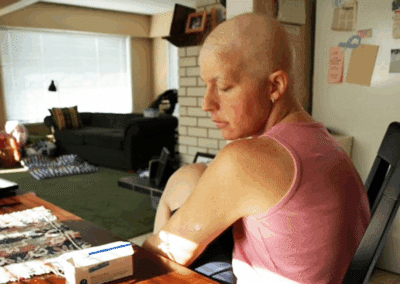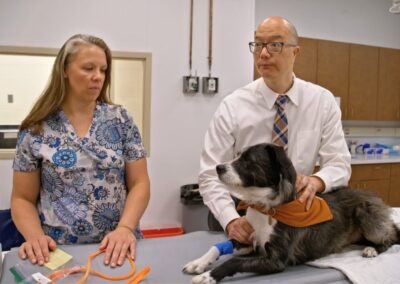That standard osteosarcoma treatment protocol is combination chemotherapy (called the MAP regimen), followed by surgery, and then more MAP chemotherapy. This approach can result in a wide range of cancer therapy side effects that affect patients during and after treatment. Both chemotherapy and surgery can cause physical side effects, many of which may continue even after cancer treatment ends.
Physical Side Effects of Chemo
The MAP chemotherapy protocol includes three drugs: methotrexate, Adriamycin (doxorubicin), and Platinol (cisplatin). Each of these drugs plays an essential role in targeting cancer cells, but they also affect healthy cells. Some of the most common side effects of chemotherapy include:
Weakened immune system. Chemotherapy targets fast-dividing cells, which includes not only cancer cells but also healthy white blood cells that are needed to fight infections.
Hair loss. Hair root cells are also fast-growing, making them an unintentional target for chemotherapy drugs.
Nausea and vomiting. Platinol and Adriamycin are particularly known for causing nausea and vomiting. Medications called antiemetics can help.
Heart problems. “Adriamycin is really bad for your heart. It is known to be cardiotoxic,” Dr. Weiss says. Patients are monitored throughout treatment with echocardiograms, an imaging test that checks the health of the heart.
Kidney damage. High-dose methotrexate can be toxic to the kidneys, making proper hydration essential so the body can effectively flush it out of the system.
Hearing loss. Chemotherapy can cause permanent damage to cells in the inner ear, especially affecting the ability to hear high-pitched sounds.
Neuropathy. Cisplatin can be particularly tough on the nerves, Dr. Weiss says, leading to numbness, tingling, or pain in the hands and feet. These symptoms often subside when treatment ends, but it is possible for them to persist.
Fatigue. Cancer can cause fatigue on its own, and chemotherapy drugs can add to this symptom.
Infertility. Adriamycin has the potential to cause infertility across sexes. Fertility preservation options should be discussed before treatment begins.
Even after osteosarcoma treatment ends, it is important to monitor for late or lingering side effects of chemo.
Physical Side Effects of Surgery
Surgery for osteosarcoma removes the entire tumor, which includes the bone and surrounding tissue involved.
“We intentionally create big holes in the patient’s skeleton,” says Dr. Weiss, who is also the vice chair of translational research and director of the musculoskeletal oncology lab at the University of Pittsburgh School of Medicine. “This is not a simple hip replacement or a knee replacement, because we are not merely replacing the end of the bone. We are replacing a chunk of the skeleton.”
Surgeons typically use a megaprosthesis to replace the removed bone. These custom implants can be designed to grow with pediatric patients.
When limb preservation is not possible, amputation may be recommended. One specialized form of leg amputation is called a rotationplasty. This surgical option, most often used for osteosarcoma found near the knee, allows for greater mobility by repositioning the lower leg and foot to function as a knee joint, using the body’s natural structures.
“This is a kind of amputation, but it enables you to turn an above-the-knee amputation into a below-the-knee amputation,” explains Dr. Weiss, who is an osteosarcoma survivor himself. “Being able to have a biological knee that your muscles and your nerves can control is huge from a functional standpoint.”
In addition to managing life with a prosthesis, potential physical side effects include:
- Infection at the surgical site,potentially leading to additional procedures or, in rare cases, amputation.
- Wearing out of the prosthesis,which may require future revision surgery.
- Outgrowing the prosthesis,especially in younger patients, which can also require additional surgeries.
After surgery, physical therapy is crucial to help patients regain strength and mobility.
Managing Cancer Therapy Side Effects
While many cancer treatment side effects are temporary, some may last for months or years. It is important to discuss any concerns with your oncology team. There are medications and strategies to help manage side effects, and in some cases, treatment plans can be adjusted to reduce risk.
“It is all incredibly invasive and life-changing, and the patient and their family have to deal with the consequences for the rest of their life,” Dr. Weiss says. “My daily reminder of osteosarcoma is I have to put my leg on to go to work.”
No one should navigate these cancer treatment side effects alone. Support, education, and communication with care teams can help ensure that the challenges of balancing treatment with quality of life are met with compassion and expert care.








